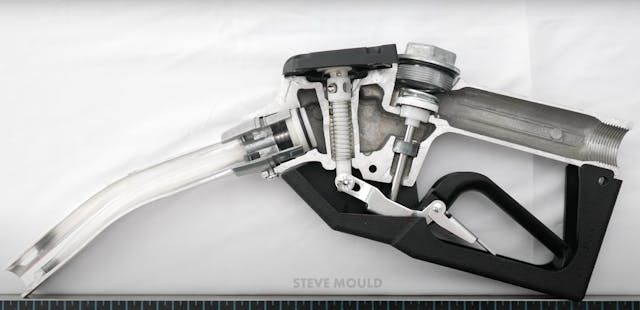Media | Articles
How the Venturi effect enables gas pump shutoffs and carburetors
The world is ruled by the laws of physics. Because of that, seemingly unrelated actions can sometimes be a lot closer related than we sometimes realize. Still, when I learned that the same physics principle that makes carburetors work is also what makes the gas pump shut off automatically when your tank is full, I was a little surprised. Maybe the Venturi effect will surprise you, too.
This video comes from British YouTube personality Steve Mould, but luckily the pump handle and function are the same here in the states. At the start of the video he lays out the same thought I have always had about how one of these automatic shutoff pump handles works; there is some type of electronic sensor that can tell when fuel splashes against it and trips the pump to stop. Now, I have to admit that in the back of my mind I knew it could never be that, because fuel vapors and electronics—especially electronics used by the general public—could never get along without significantly more gas station explosions than history has shown us. That was true, but the actual correct answer was way more complicated than I expected.
In the simplest terms, the handle creates a slight vacuum at the tip of the filler nozzle and if that vacuum port is plugged a mechanism shuts a valve and stops fuel flow. Super simple, right? Sort of.
The most interesting part is that the nozzle uses the fuel being pumped to create the Venturi that activates the shutoff. To do that it has a small restriction that creates a low-pressure zone just before the nozzle in the handle. This slight vacuum spikes if the tip of the nozzle is no longer in air, but instead in fuel. That spike in vacuum moves a diaphragm which changes the pivot point of the trigger and stops fuel flow.
Marketplace
Buy and sell classics with confidence
It is both complicated and simple. The fact that there is very little to wear out or require service makes it the perfect piece that can be in use at a fuel station basically all day. Seeing inside regular objects like this to peek at the hidden engineering is always fascinating. Now that my brain knows this it can move on to wondering exactly how those oil life indicators work on modern cars. It is an algorithm of engine use or really sensing a change within the oil? Maybe we’ll dig into that ourselves.











Funny how one can go through life wondering how some “everyday something” actually works, but never looks into it. I now can amaze my friends with this knowledge! 😉
I thought it was a vacuum thing but forgot about the Venturi effect. Now I know.
In the case of the pump handles some times how it won’t shut off.
Venturi is used to create cold air in painting and sandblasting helmets. Compressed Air travels through Venturi valve causing the air to spin, the spinning causes the hot air to separate from the cold. The hot air exhaust’s out of the valve and cold is directed to helmet.
What is going on with the Comments Section?
The formatting seems to be all changed, and “Log-In” also seems required all the time.
It is another case of “If it ain’t broke, don’t fix it.”
When is Hagerty going to learn this lesson?
Wasn’t “Colonel Bleep” enough?
September 25? A voice from the future? Hagerty’s done it again. Brilliant!!!